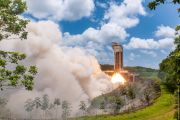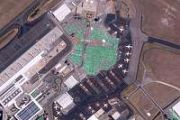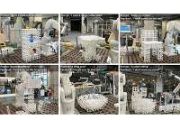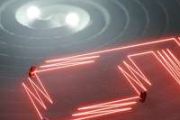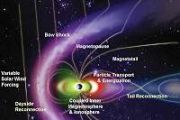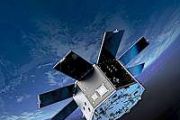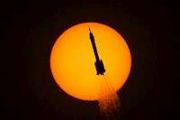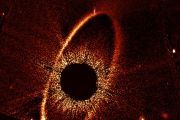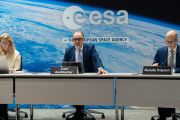
Copernical Team
Australian startups join forces to test AI computing in space
 Two emerging Australian space startups - AICRAFT and Antaris Space Space - have signed of a memorandum of understanding (MOU) to test new Artificial Intelligence and Machine Learning (AI/ML) models in space, with the goal of developing and space-qualifying new computational capabilities for satellite-based applications.
Under the MoU the two startups, who are both members of the SmartSAT C
Two emerging Australian space startups - AICRAFT and Antaris Space Space - have signed of a memorandum of understanding (MOU) to test new Artificial Intelligence and Machine Learning (AI/ML) models in space, with the goal of developing and space-qualifying new computational capabilities for satellite-based applications.
Under the MoU the two startups, who are both members of the SmartSAT C HKATG is getting ready for its Golden Bauhinia Constellation
 HKATG has successfully launched five satellites for its "Golden Bauhinia Constellation" in 2021, the aerospace development plan shows no sign of slowing down in 2022.
In January 2022, HKST announced that the Group has planned to launch two satellites named "Golden Bauhinia Satellite No. 3" and "Golden Bauhinia Satellite No. 4" in 2022 Q3, with the target launch time tentatively being sched
HKATG has successfully launched five satellites for its "Golden Bauhinia Constellation" in 2021, the aerospace development plan shows no sign of slowing down in 2022.
In January 2022, HKST announced that the Group has planned to launch two satellites named "Golden Bauhinia Satellite No. 3" and "Golden Bauhinia Satellite No. 4" in 2022 Q3, with the target launch time tentatively being sched Space exploration made lighter, more flexible with new product from Nicomatic
 Nicomatic, the Pennsylvania-based provider of creative interconnect solutions, announces the release of a new product line for use in spacecraft: Flat Flexible Cables for Space. The flat flexible cable technology allows for lighter, more flexible space exploration of both satellites and spacecraft in low earth orbit, geosynchronous orbit, and beyond. Nicomatic's new product line has contributed
Nicomatic, the Pennsylvania-based provider of creative interconnect solutions, announces the release of a new product line for use in spacecraft: Flat Flexible Cables for Space. The flat flexible cable technology allows for lighter, more flexible space exploration of both satellites and spacecraft in low earth orbit, geosynchronous orbit, and beyond. Nicomatic's new product line has contributed NASA's NuSTAR Makes Illuminating Discoveries With 'Nuisance' Light
 For almost 10 years, NASA's NuSTAR (Nuclear Spectroscopic Telescope Array) X-ray space observatory has been studying some of the highest-energy objects in the universe, such as colliding dead stars and enormous black holes feasting on hot gas. During that time, scientists have had to deal with stray light leaking in through the sides of the observatory, which can interfere with observations much
For almost 10 years, NASA's NuSTAR (Nuclear Spectroscopic Telescope Array) X-ray space observatory has been studying some of the highest-energy objects in the universe, such as colliding dead stars and enormous black holes feasting on hot gas. During that time, scientists have had to deal with stray light leaking in through the sides of the observatory, which can interfere with observations much What's happening in the depths of distant worlds?
 The physics and chemistry that take place deep inside our planet are fundamental to the existence of life as we know it. But what forces are at work in the interiors of distant worlds, and how do these conditions affect their potential for habitability?
New work led by Carnegie's Earth and Planets Laboratory uses lab-based mimicry to reveal a new crystal structure that has major implicatio
The physics and chemistry that take place deep inside our planet are fundamental to the existence of life as we know it. But what forces are at work in the interiors of distant worlds, and how do these conditions affect their potential for habitability?
New work led by Carnegie's Earth and Planets Laboratory uses lab-based mimicry to reveal a new crystal structure that has major implicatio New astrobiology research predicts life 'as we don't know it'
 The search for alien life has been restricted to using life on Earth as the reference, essentially looking for "life as we know it" beyond Earth. For astrobiologists looking for life on other planets, there are simply no tools for predicting the features of "life as we don't know it."
In new research published in the Proceedings of the National Academy of Sciences (PNAS), a team of scienti
The search for alien life has been restricted to using life on Earth as the reference, essentially looking for "life as we know it" beyond Earth. For astrobiologists looking for life on other planets, there are simply no tools for predicting the features of "life as we don't know it."
In new research published in the Proceedings of the National Academy of Sciences (PNAS), a team of scienti Sols 3401-3402: Sand, Boulders and Ridges, Oh My
 Curiosity has been picking her way through sand, sharp boulders and ridges to find a way up onto the Greenheugh pediment. We briefly explored the pediment more than 600 sols ago, before resuming our traverse over the Mount Sharp group sedimentary rocks that we have been driving over since ~sol 750.
The science team is excited to drive up onto and investigate the very different looking rock
Curiosity has been picking her way through sand, sharp boulders and ridges to find a way up onto the Greenheugh pediment. We briefly explored the pediment more than 600 sols ago, before resuming our traverse over the Mount Sharp group sedimentary rocks that we have been driving over since ~sol 750.
The science team is excited to drive up onto and investigate the very different looking rock NASA Announces Launch Options for 2022 Student Launch Competition
 NASA's 2022 Student Launch rocketry challenge will provide both in-person and virtual opportunities for the competition's culminating event. The in-person option will include a two-day event, with hardware checks Friday, April 22, and launch day Saturday, April 23, in Huntsville, Alabama. If rain is a factor April 23, a makeup day is scheduled for Sunday, April 24.
Alternatively, Launch Di
NASA's 2022 Student Launch rocketry challenge will provide both in-person and virtual opportunities for the competition's culminating event. The in-person option will include a two-day event, with hardware checks Friday, April 22, and launch day Saturday, April 23, in Huntsville, Alabama. If rain is a factor April 23, a makeup day is scheduled for Sunday, April 24.
Alternatively, Launch Di Atlas V rocket launches new NOAA weather satellite
 NASA launched the latest in an advanced series of weather satellites, the GOES-T, from Florida on Tuesday to improve weather forecasting over the Pacific and western United States.
United Launch Alliance's Atlas V lifted off as planned into a mostly sunny sky at 4:38 p.m. EST from Complex 41 at Cape Canaveral Space Force Station.
Meteorologists around the world are looking forward to
NASA launched the latest in an advanced series of weather satellites, the GOES-T, from Florida on Tuesday to improve weather forecasting over the Pacific and western United States.
United Launch Alliance's Atlas V lifted off as planned into a mostly sunny sky at 4:38 p.m. EST from Complex 41 at Cape Canaveral Space Force Station.
Meteorologists around the world are looking forward to NASA to launch sophisticated weather satellite
 NASA plans to launch the latest in an advanced series of weather satellites, the GOES-T, from Florida on Tuesday to improve weather forecasting over the Pacific and western United States.
United Launch Alliance's Atlas V rocket is prepared for liftoff during a two-hour window starting at 4:38 p.m. EST from Complex-41 at Cape Canaveral Space Force Station.
Meteorologists around th
NASA plans to launch the latest in an advanced series of weather satellites, the GOES-T, from Florida on Tuesday to improve weather forecasting over the Pacific and western United States.
United Launch Alliance's Atlas V rocket is prepared for liftoff during a two-hour window starting at 4:38 p.m. EST from Complex-41 at Cape Canaveral Space Force Station.
Meteorologists around th 











